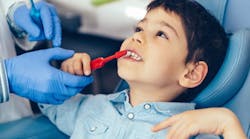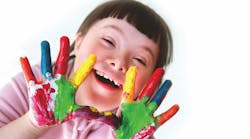OT and RDH collaboration can break down oral health barriers for autistic children
Listen to the article on our podcast!
What you'll learn in this article
- Understand unique oral health challenges autistic children face and how they affect daily life.
- Learn how autism-related characteristics create barriers to successful dental care and oral hygiene.
- Discover how occupational therapists help autistic children develop essential oral hygiene and dental visit skills.
- Explore collaborative strategies between dental professionals and OTs to improve care for autistic children.
- Gain practical tools like social narratives and sensory adaptations to support autistic children in dental settings.
Contributing authors:
Nicole Stotz, PhD, OTR/L
Ashley Heilman, OTD, OTR/L
Nicole Buchanan, MPH, RDH
In 2020, one in 36 children aged 8 years (approximately 4% of boys and 1% of girls) were estimated to be autistic, according to the CDC Autism and Developmental Disabilities Monitoring Network. In addition, more recent statistics by the CDC are even more alarming and state: Among children aged 8 years in 2022, ASD prevalence was 32.2 per 1,000 children (one in 31) across the 16 sites, ranging from 9.7 in Texas (Laredo) to 53.1 in California.1
There is a high likelihood of interacting with this population in the health-care setting, including dental offices. The needs of autistic children should be identified and addressed by their health-care professionals.
Oral health is one of the most common unmet health needs for children.2 Current research indicates that autistic children experience significant unmet oral health needs and are likely to have poor oral health.3 The effects of poor oral health can impact a child’s overall health and lead to decreased quality of life.4,5 Poor oral health may impact their ability to eat, sleep, and perform daily activities.5
Barriers to oral health for this population can be related to common autism characteristics, systemic-related barriers, or barriers stemming from the dental or home oral care environments.3,6-8 Sensory sensitivities, communication differences, and challenging behaviors are common characteristics of autism spectrum disorder that could serve as barriers.3,6,9-13
Sensory sensitivities impact how the child interprets and processes sensory information from their own body and the environment.14 For example, in a dental office some children may be overresponsive to sound, light, and smells. The information they process can be the noises from the dental equipment, the bright dental lights, and the scent of the toothpaste.
Communicating with this population varies depending on the child. Some struggle with nonverbal communication, such as body language, eye contact, and different social cues. Others are nonverbal, require additional support for communication, or use augmentative and alternative communication devices to express their needs.
Without proper communication supports, it’s difficult for a child to express pain, discomfort, or their desire for a break during treatment. Challenging behaviors can also serve as barriers to dental care, including tantrums, aggression, and self-injurious behavior.15 Each autistic child has unique needs. It’s important to identify and understand these needs within the dental office to provide the best care possible.
How occupational therapy helps
Occupational therapy (OT) is a holistic profession that works with this population, and it’s one of the most common interventions for autistic children.16 OT addresses engagement in occupations to increase individuals' overall health and well-being.17 Occupations are explained by the World Federation of Occupational Therapists (WFOT) as “things people need to do, want to do, or are expected to do.”18
Occupations include activities of daily living (ADL), which encompass personal hygiene. Oral hygiene tasks that can be addressed by OT are “cleaning mouth, brushing and flossing teeth, as well as removing, cleaning, and reinserting dental orthotics and prosthetics.”17
OTs assess and address the needs of their patients through a variety of treatment approaches, such as restoring or establishing skills needed for the occupation, modifying the task or the environment, and many other treatments to improve engagement.17
Collaborating with an OT can help dental professionals identify the unique needs of autistic children to provide them with optimal care. For example, specific OT strategies to increase engagement in oral health may be social narratives, visual schedules, sensory related changes to the environment, motor skill development, and assistive technology for oral hygiene tasks.
If a patient has difficulty with certain oral hygiene tasks (e.g., toothbrushing) or engaging in the routine cleaning appointment, identifying if they receive OT services could be a first step toward a collaboration opportunity. The dental professional, parent, and OT can collaborate to develop strategies to address the child’s difficulties with oral care.
For example, if the difficulty is engaging in a routine cleaning, an OT can implement a social narrative during the OT sessions before the child’s next dental visit. A social narrative is a story created to increase engagement in different situations.19 Key characteristics are the use of first-person language, positive phrasing, and visuals that address common details of the situation such as who, what, and where.19 The OT may also educate the parent/caregiver how to use this technique at home to increase participation at the dental office.
Activity schedules are also used with autistic children to provide support. These schedules can assist the child in the initiation and completion of tasks, routines, and activities.20 This strategy is taught by an OT to increase independence with the schedule and can then be used at the dental office to increase participation.20
Another option to make the dental visit smooth is to reach out to pediatric OTs for ideas for working with this population. One is the use of sensory adapted dental environments (SADEs). SADEs have been suggested by the American Academy of Pediatric Dentistry (AAPD) in their best practices for behavior guidance for children with special needs.21 SADEs are intended to adapt visual, auditory, and tactile sensory domains.
Sensory changes that can be implemented in your office could include dimmed lighting, avoiding the child's visual field while using a head lamp, slow moving visual effects projected on the ceiling, calming music, and a deep tactile pressure wrap.22
Dental health is important for all, including those with autism spectrum disorder. Collaboration between dental hygiene and occupational therapy uses the strengths of each profession to create positive dental visits and improve various oral hygiene tasks for the autistic population. This collaboration can impact autistic children’s oral health outcomes and positively impact their quality of life.
Author’s note: I’m grateful to have worked with Samantha Stanley the past several months. It was a great opportunity to learn about occupational therapy and how it can be beneficial in the dental setting. Samantha created a social narrative and activity schedule that we plan to use in our clinic for autistic patients. There is much to learn through the collaboration of dental hygiene and occupational therapy. — Nicole Buchanan, MPH, RDH, full-time dental hygiene faculty, Owens Community College
Editor's note: This article appeared in the August/September 2025 print edition of RDH magazine. Dental hygienists in North America are eligible for a complimentary print subscription. Sign up here.
References
- Maenner MJ, Shaw KA, Baiou J, et al. Prevalence of autism spectrum disorder among children aged 8 years—Autism and Developmental Disabilities Monitoring Network, 11 sites, United States, 2020. MMWR Morb Mortal Wkly Rep. 2023;72(2):50-56. doi:10.15585/mmwr.ss6904a1
- Fenning RM, Butter EM, Macklin EA, et al. Parent training for dental care in underserved children with autism: a randomized controlled trial. Pediatrics. 2022;149(5):1-12. doi:10.1542/peds.2021-050691
- Erwin J, Paisi M, Neill S, et al. Factors influencing oral health behaviours, access and delivery of dental care for autistic children and adolescents: a mixed-methods systematic review. Health Expect. 2022;25:1269-1318. doi:10.1111/hex.13544
- Stein Duker LI, Henwood BF, Bluthenthal RN, et al. Parents’ perceptions of dental care challenges in male children with autism spectrum disorder: an initial qualitative exploration. Res Autism Spectr Disord. 2017;39:63-72. doi:10.1016/j.rasd.2017.03.002
- Norwood KW, Slayton RL. Clinical report: oral care for children with developmental disabilities. Pediatrics. 2013;131(3):614-619. doi:10.1542/peds.2012-3650
- Alshihri A, Fitzgibbon J, Mungall E, et al. Barriers to dental care for children with autism spectrum disorders. Pediatr Dent. 2021;43(1):58-65 doi:10.1007/s10803-020-04759-y\
- Chi DL, Momany ET, Mancl LA, Lindgren SD, Zinner SH, Steinman KJ. Dental homes for children with autism: a longitudinal analysis of Iowa Medicaid's I-Smile program. Am J Prev Med. 2016;50(5):609-615. doi:10.1016/j.amepre.2015.08.022
- Roux A, Chvasta K, Koffer Miller K, et al. National Autism Indicators Report: Introduction to Medicaid and Autism. Policy Insight Series. A.J. Drexel Autism Institute; 2023. doi:10.17918/nair_medicaid_2023
- Cermak SA, Stein Duker LI, Williams ME, Dawson ME, Lane CJ, Polido JC. Sensory adapted dental environments to enhance oral care for children with autism apectrum disorders: a randomized controlled pilot study. J Autism Dev Disord. 2015;45(9):2876-2888. doi:10.1007/s10803-015-2450-5
- Como DH, Stein Duker LI, Polido JC, Cermak SA. Oral health and autism spectrum disorders: a unique collaboration between dentistry and occupational therapy. Int J Environ Res Publ Health. 2021;18(1):135. https://doi.org/10.3390/ijerph18010135
- George SS, Elenjickal MG, Naik S, et al. Oral health status and dental treatment needs in children with autism spectrum disorder. Heliyon. 2024;10(18):e37728. doi:10.1016/j.heliyon.2024.e37728
- Jones RM, Roberts E, Cockrell D, et al. Barriers to oral care in children with autism spectrum disorder: a clinical perspective. J Autism Dev Disord. 2024;54(2):340-351. doi:10.3390/healthcare12010103
- Stein Duker LI, Henwood BF, Bluthenthal RN, Juhlin E, Polido JC, Cermak SA. Parents’ perceptions of dental care challenges in male children with autism spectrum disorder: an initial qualitative exploration. Res Autism Spectr Disord. 2017;39:63-72. doi:10.1016/j.rasd.2017.03.002
- Atchison B, Dirette D. Introduction to the Practice of Occupational Therapy. 7th ed. Elsevier; 2016.
- Edelson SM. Understanding challenging behaviors in autism spectrum disorder: a multi-component, interdisciplinary model. J Pers Med. 2022;12(7):1127. doi:10.3390/jpm12071127
- Crasta JE, Martis J, Kromalic M, Jarrott S, Wengerd L, Darragh A. Characterizing occupational therapy intervention for children on the autism spectrum. Am J Occup Ther. 2024;78:7805205210. doi:10.5014/ajot.2024.050734
- Occupational therapy practice framework: Domain and process. 4th ed. American Occupational Therapy Association; 2020.
- Definition of occupational therapy. World Federation of Occupational Therapists (WFOT); 2012.
- Como DH, Goodfellow M, Hudak D, Cermak SA. A scoping review: social stories supporting behavior change for individuals with Autism. J Occup Ther Sch Early Interv. 2024;17(1):154-175. doi:10.1080/19411243.2023.2168824
- Genc-Tosun D, Yucesoy-Ozkan S, Dalgin O. How do the activity schedules impact the children with autism spectrum disorder? A meta-analysis. J Theor Educ Sci. 2023;16(1):1-19. http://doi.org/10.30831/akukeg.1109787
- Behavior guidance for the pediatric dental patient. In: The Reference Manual of Pediatric Dentistry. American Academy of Pediatric Dentistry; 2024:358-378.
- Stein Duker LI, Como DH, Jolette C, et al. Sensory adaptations to improve physiological and behavioral distress during dental visits in autistic children: a randomized crossover trial. JAMA Netw Open. 2023;6(6):e2316346. doi:10.1001/jamanetworkopen.2023.16346
About the Author
Samantha Stanley, OTD, OTR/L
Samantha recently became a registered and licensed occupational therapist. She completed her doctoral capstone focused on client and professional advocacy under Ashley Heilman, OTD, OTR/L, and Nicole Stotz, PhD, OTR/L. Samantha is now a registered occupational therapist and is in the process of obtaining her license to practice. She is actively seeking job opportunities to apply her passion for advocacy and patient care.


